How Is Forest Landscape Restoration Being Implemented in Burkina Faso? Overview of Ongoing Initiatives
Abstract
1. Introduction
2. Materials and Methods
3. Results
3.1. Characteristics of FLR Initiatives Implemented in Burkina Faso
3.2. Different FLR Approaches Adopted
4. Discussion
4.1. Types of FLR Initiatives in Place in Burkina Faso
4.2. FLR Approaches Adopted
5. Conclusions
Supplementary Materials
Author Contributions
Funding
Conflicts of Interest
References
- Gibbs, H.K.; Salmon, J.M. Mapping the world’s degraded lands. Appl. Geogr. 2015, 57, 12–21. [Google Scholar] [CrossRef]
- Lamb, D.; Erskine, P.D.; Parrotta, J.A. Restoration of degraded tropical forest landscapes. Science 2005, 310, 1628–1632. [Google Scholar] [CrossRef] [PubMed]
- IUCN; WWF. Forests Reborn: A workshop on forest restoration. In Proceedings of the WWF/IUCN International Workshop on Forest Restoration, Segovia, Spain, 3–5 July 2000. [Google Scholar]
- Mansourian, S.; Dudley, N.; Vallauri, D. Forest Landscape Restoration: Progress in the Last Decade and Remaining Challenges. Ecol. Restor. 2017, 35, 281–288. [Google Scholar] [CrossRef]
- Lamb, D.; Stanturf, J.; Madsen, P. What Is Forest Landscape Restoration? In Forest Landscape Restoration; Stanturf, J., Lamb, D., Madsen, P., Eds.; Springer: Dordrecht, The Netherlands, 2012; Volume 15, pp. 3–23. ISBN 978-94-007-5325-9. [Google Scholar]
- Brancalion, P.H.S.; Chazdon, R.L. Beyond hectares: Four principles to guide reforestation in the context of tropical forest and landscape restoration: Forest and landscape rest oration principles. Restor. Ecol. 2017, 25, 491–496. [Google Scholar] [CrossRef]
- McDonald, T.; Gann, G.D.; Jonson, J.; Dixon, K.W. International Standards for the Practice of Ecological Restoration—Including Principles and Key Concepts; Society for Ecological Restoration: Washington, DC, USA, 2016; p. 48. [Google Scholar]
- Chazdon, R.L.; Brancalion, P.H.S.; Laestadius, L.; Bennett-Curry, A.; Buckingham, K.; Kumar, C.; Moll-Rocek, J.; Vieira, I.C.G.; Wilson, S.J. When is a forest a forest? Forest concepts and definitions in the era of forest and landscape restoration. Ambio 2016, 45, 538–550. [Google Scholar] [CrossRef] [PubMed]
- Food and Agriculture Organization. Global Guidelines for the Restoration of Degraded Forests and Landscapes in Drylands: Building Resilience and Benefiting Livelihoods; Forestry Paper No. 175; Food and Agriculture Organization of the United Nations: Rome, Italy, 2015. [Google Scholar]
- Convention on Biological Diversity (CBD). Strategic Plan for Biodiversity 2011–2020. 2011. Available online: https://www.cbd.int/sp/targets/default.shtml (accessed on 3 December 2020).
- IUCN and WRI. A Guide to the Restoration Opportunities Assessment Methodology (ROAM): Assessing Forest Landscape Restoration Opportunities at the National or Sub-National Level; IUCN: Gland, Switzerland, 2014. [Google Scholar]
- United Nations (UN). Social Development Goals, Goal 15: Sustainably Manage Forests, Combat Desertification, Halt and Reverse Land Degradation, Halt Biodiversity Loss. 2015. Available online: https://www.un.org/sustainabledevelopment/sustainable-development-goals/ (accessed on 3 December 2020).
- Ministère de l’Environnement, de l’Economie Verteet du Changement Climatique du Burkina Faso (MEEVCC). Rapport Final, Programme de Définition des Cibles de la Neutralité en Matière de Dégradation des Terres (PDC/NDT), Burkina Faso; MEEVCC: Ouagadougou, Burkina Faso, 2018. [Google Scholar]
- Food Agriculture Organization. Global Forest Resources Assessment; UN Food Agriculture Organization: Rome, Italy, 2015. [Google Scholar]
- Ouedraogo, I.; Mbow, C.; Balinga, M.; Neufeldt, H. Transitions in Land Use Architecture under Multiple Human Driving Forces in a Semi-Arid Zone. Land 2015, 4, 560–577. [Google Scholar] [CrossRef]
- Murcia, C.; Guariguata, M.R. La Restauración Ecológica en Colombia: Tendencias, Necesidades y Oportunidades; Centre for International Forestry Research: Bogor, Indonesia, 2014; ISBN 978-602-1504-35-2. [Google Scholar]
- Ministère de l’Environnement, de l’Economie Verte et du Changement Climatique du Burkina Faso (MEEVCC). Plan d’Action de Reforestation du Burkina Faso 2018–2022; MEEVCC: Ouagadougou, Burkina Faso, 2017. [Google Scholar]
- Gammoh, I.A.; Oweis, T.Y. Contour Laser Guiding for the Mechanized “Vallerani” Micro-catchment Water Harvesting Systems. J. Environ. Sci. Eng. 2011, 5, 1309–1316. [Google Scholar]
- Zida, M. Reshaping the Terrain: Forest and Landscape Restoration in Burkina Faso. Global LANDSCAPE Forum Factsheet. 2018. Available online: https://www.cifor.org/publications/pdf_files/factsheet/6984-GLF_Factsheet.pdf (accessed on 11 December 2020).
- Girard, H. Wégoubri, the sahelian bocage: An integrate approach for environment preservation and social development in sahelian agriculture (Burkina Faso). Field Actions Sci. Rep. 2009, 2, 33–39. [Google Scholar] [CrossRef]
- Belem, B.; Kaguembega-Mueller, F.; Bellefontaine, R.; Sorg, J.R.; Bloesch, U.; Graf, E. Assisted natural regeneration with fencing central and northern zones of Burkina Faso. Tropicultura 2017, 35, 73–86. [Google Scholar] [CrossRef]
- Gutierrez, V.; Keijzer, M.-N. Funding forest landscape restoration using a business-centred approach: An NGO’s perspective. Unasylva 2015, 245, 99–106. [Google Scholar]
- Schuyt, K. Opportunities for long term financing of forest restoration in landscapes. In Forest Restoration in Landscapes—Beyond Planting Trees; Mansourian, S., Vallauri, D., Dudley, N., Eds.; Springer: New York, NY, USA, 2005; pp. 161–176. [Google Scholar]
- Zizka, A.; Thiombiano, A.; Dressler, S.; Nacoulma, B.M.; Ouédraogo, A.; Ouédraogo, I.; Ouédraogo, O.; Zizka, G.; Hahn, K.; Schmidt, M. Traditional plant use in Burkina Faso (West Africa): A national-scale analysis with focus on traditional medicine. J. Ethnobiol. Ethnomed. 2015, 11, 9. [Google Scholar] [CrossRef] [PubMed]
- Ouedraogo, B. Household energy preferences for cooking in urban Ouagadougou, Burkina Faso. Energy Policy 2006, 34, 3787–3795. [Google Scholar] [CrossRef]
- Shackleton, C.M.; Shackleton, S.E.; Buiten, E.; Bird, N. The importance of dry woodlands and forests in rural livelihoods and poverty alleviation in South Africa. Forest Policy Econ. 2007, 9, 558–577. [Google Scholar] [CrossRef]
- Gadzama, N.M. Attenuation of the effects of desertification through sustainable development of Great Green Wall in the Sahel of Africa. World J. Sci. Technol. Sustain. Dev. 2017, 14, 279–289. [Google Scholar] [CrossRef]
- Goffner, D.; Sinare, H.; Gordon, L.J. The Great Green Wall for the Sahara and the Sahel Initiative as an opportunity to enhance resilience in Sahelian landscapes and livelihoods. Reg. Environ. Chang. 2019, 19, 1417–1428. [Google Scholar] [CrossRef]
- Reenberg, A. Insistent Dryland Narratives: Portraits of Knowledge about Human-Environmental Interactions in Sahelian Environment Policy Documents. West Afr. J. Appl. Ecol. 2012, 20, 97–111. [Google Scholar]
- O’Connor, D.; James, F. Increasing the Effectiveness of the “Great Green Wall” as an Adaptation to the Effects of Climate Change and Desertification in the Sahel. Sustainability 2014, 6, 7142–7154. [Google Scholar] [CrossRef]
- Coulibaly-Lingani, P.; Savadogo, P.; Tigabu, M.; Oden, P.-C. Factors influencing people’s participation in the forest management program in Burkina Faso, West Africa. Forest Policy Econ. 2011, 13, 292–302. [Google Scholar] [CrossRef]
- Ndangalasi, H.J.; Bitariho, R.; Dovie, D.B.K. Harvesting of non-timber forest products and implications for conservation in two montane forests of East Africa. Biol. Conserv. 2007, 134, 242–250. [Google Scholar] [CrossRef]
- Bougma, L.A.; Sawadogo, N.; Ouedraogo, M.H.; Ouedraogo, M.; Balma, D.; Sawadogo, M. Overview of the Burkina Faso seed system: Case of the formal seed system. Int. J. Agric. Policy Res. 2018, 6, 169–175. [Google Scholar]
- Sacande, M.; Berrahmouni, N.; Hargreaves, S. Community participation at the heart of Africa’s Great Green Wall restoration model. Unasylva 2015, 66, 44–51. [Google Scholar]
- Sacande, M.; Berrahmouni, N. Community participation and ecological criteria for selecting species and restoring natural capital with native species in the Sahel: Restoring natural capital in the Sahel. Restor. Ecol. 2016, 24, 479–488. [Google Scholar] [CrossRef]
- Gómez, J.M.; Hódar, J.A.; Baraza, E.; Gómez-Aparicio, L.; Castro, J.; Zamora, R. Applying Plant Facilitation To Forest Restoration: A Meta-Analysis of the Use of Shrubs As Nurse Plants. Ecol. Appl. 2004, 14, 1128–1138. [Google Scholar] [CrossRef]
- Gómez-Aparicio, L.; Gómez, J.M.; Zamora, R.; Boettinger, J.L. Canopy vs. soil effects of shrubs facilitating tree seedlings in Mediterranean montane ecosystems. J. Veg. Sci. 2005, 16, 191–198. [Google Scholar] [CrossRef]
- Bogie, N.A.; Bayala, R.; Diedhiou, I.; Conklin, M.H.; Fogel, M.L.; Dick, R.P.; Ghezzehei, T.A. Hydraulic Redistribution by Native Sahelian Shrubs: Bioirrigation to Resist In-Season Drought. Front. Environ. Sci. 2018, 6. [Google Scholar] [CrossRef]
- Dossa, E.L.; Khouma, M.; Diedhiou, I.; Sene, M.; Kizito, F.; Badiane, A.N.; Samba, S.A.N.; Dick, R.P. Carbon, nitrogen and phosphorus mineralization potential of semiarid Sahelian soils amended with native shrub residues. Geoderma 2009, 148, 251–260. [Google Scholar] [CrossRef]
- Hernandez, R.R.; Debenport, S.J.; Leewis, M.C.C.E.; Ndoye, F.; Nkenmogne, K.I.E.; Soumare, A.; Thuita, M.; Gueye, M.; Miambi, E.; Chapuis-Lardy, L.; et al. The native shrub, Piliostigma reticulatum, as an ecological “resource island” for mango trees in the Sahel. Agric. Ecosyst. Environ. 2015, 204, 51–61. [Google Scholar] [CrossRef][Green Version]
- Baynes, J.; Gregorio, N. Nursery Training for Smallholders: An Evaluation of Two Extension Programs in the Philippines. Small-Scale For. 2008, 7, 387–401. [Google Scholar] [CrossRef]
- Farmers’ Planting Practices in Burkina Faso: A Survey Carried Out by the Project “Improved Seed Supply for Agroforestry in African Countries. Available online: https://www.semanticscholar.org/paper/Farmers%27-planting-practices-in-Burkina-Faso-A-out-R%C3%A6bild-Bassirou/7ab1d41b668614a105db32263e272e6dd922f1e2 (accessed on 11 December 2020).
- Belem, B.; Nacoulma, B.M.I.; Gbangou, R.; Kambou, S.; Hansen, H.H.; Gausset, Q.; Lund, S.; Raebild, A.; Lompo, D.; Ouedraogo, M.; et al. Use of Non Wood Forest Products by local people bordering the “Parc National Kaboré Tambi”, Burkina Faso. J. Transdiscipl. Environ. Stud. 2007, 6, 1–21. [Google Scholar]
- Lykke, A.M.; Kristensen, M.K.; Ganaba, S. Valuation of local use and dynamics of 56 woody species in the Sahel. Biodivers. Conserv. 2004, 13, 1961–1990. [Google Scholar] [CrossRef]
- Suárez, A.; Williams-Linera, G.; Trejo, C.; Valdez-Hernández, J.I.; Cetina-Alcalá, V.M.; Vibrans, H. Local knowledge helps select species for forest restoration in a tropical dry forest of central Veracruz, Mexico. Agrofor. Syst. 2012, 85, 35–55. [Google Scholar] [CrossRef]
- Bayen, P.; Lykke, A.M.; Thiombiano, A. Success of three soil restoration techniques on seedling survival and growth of three plant species in the Sahel of Burkina Faso (West Africa). J. For. Res. 2016, 27, 313–320. [Google Scholar] [CrossRef]
- Crouzeilles, R.; Ferreira, M.S.; Chazdon, R.L.; Lindenmayer, D.B.; Sansevero, J.B.B.; Monteiro, L.; Iribarrem, A.; Latawiec, A.E.; Strassburg, B.B.N. Ecological restoration success is higher for natural regeneration than for active restoration in tropical forests. Sci. Adv. 2017, 3, e1701345. [Google Scholar] [CrossRef]
- Haglund, E.; Ndjeunga, J.; Snook, L.; Pasternak, D. Dry land tree management for improved household livelihoods: Farmer managed natural regeneration in Niger. J. Environ. Manag. 2011, 92, 1696–1705. [Google Scholar] [CrossRef] [PubMed]
- Sendzimir, J.; Reij, C.P.; Magnuszewski, P. Rebuilding Resilience in the Sahel: Regreening in the Maradi and Zinder Regions of Niger. Ecol. Soc. 2011, 16, art1. [Google Scholar] [CrossRef]
- Weston, P.; Hong, R.; Kaboré, C.; Kull, C.A. Farmer-Managed Natural Regeneration Enhances Rural Livelihoods in Dryland West Africa. Environ. Manag. 2015, 55, 1402–1417. [Google Scholar] [CrossRef] [PubMed]
- Rinaudo, T.; Muller, A.; Morris, M. Farmer Managed Natural Regeneration (FMNR) Manual; World Vision Australia: Melbourne, Australia, 2019. [Google Scholar]
- Descheemaeker, K.; Muys, B.; Nyssen, J.; Poesen, J.; Raes, D.; Haile, M.; Deckers, J. Litter production and organic matter accumulation in exclosures of the Tigray highlands, Ethiopia. For. Ecol. Manag. 2006, 233, 21–35. [Google Scholar] [CrossRef]
- Gebremedihin, K.; Birhane, E.; Tadesse, T.; Gbrewahid, H. Restoration of degraded drylands through exclosures enhancing woody species diversity and soil nutrients in the highlands of Tigray, Northern Ethiopia. Nat. Conserv. Res. 2018, 3. [Google Scholar] [CrossRef]
- Valette, M.; Traoré, D.; Kaguembèga-Müller, F.; Traoré, A.T.; Vinceti, B. Initiative to restore forest landscapes through household-managed fenced plots in Burkina Faso. Nat. Faune 2018, 66, 65–70. [Google Scholar]
- Gebregziabher, D.; Soltani, A. Exclosures in people’s minds: Perceptions and attitudes in the Tigray region, Ethiopia. For. Policy Econ. 2019, 101, 1–14. [Google Scholar] [CrossRef]
- Kassa, H.; Birhane, E.; Bekele, M.; Lemenih, M.; Tadesse, W.; Cronkleton, P.; Putzel, L.; Baral, H. Shared strengths and limitations of participatory forest management and area exclosure: Two major state led landscape rehabilitation mechanisms in Ethiopia. Int. For. Rev. 2017, 19, 51–61. [Google Scholar] [CrossRef]
- Ky-Dembele, C.; Tigabu, M.; Bayala, J.; Ouédraogo, S.J.; Odén, P.C. The relative importance of different regeneration mechanisms in a selectively cut savanna-woodland in Burkina Faso, West Africa. For. Ecol. Manag. 2007, 243, 28–38. [Google Scholar] [CrossRef]
- Maisharou, A.; Chirwa, P.W.; Larwanou, M.; Babalola, F.; Ofoegbu, C. Sustainable land management practices in the Sahel: Review of practices, techniques and technologies for land restoration and strategy for up-scaling. Int. For. Rev. 2015, 17, 1–19. [Google Scholar] [CrossRef]
- Chazdon, R.L.; Guariguata, M.R. Natural regeneration as a tool for large-scale forest restoration in the tropics: Prospects and challenges. Biotropica 2016, 48, 716–730. [Google Scholar] [CrossRef]
- Hänke, H.; Börjeson, L.; Hylander, K.; Enfors-Kautsky, E. Drought tolerant species dominate as rainfall and tree cover returns in the West African Sahel. Land Use Policy 2016, 59, 111–120. [Google Scholar] [CrossRef]
- Chirwa, P.W.; Mahamane, L. Overview of restoration and management practices in the degraded landscapes of the Sahelian and dryland forests and woodlands of East and southern Africa. South. For. J. For. Sci. 2017, 79, 87–94. [Google Scholar] [CrossRef]
- Sawadogo, H. Using soil and water conservation techniques to rehabilitate degraded lands in northwestern Burkina Faso. Int. J. Agric. Sustain. 2011, 9, 120–128. [Google Scholar] [CrossRef]
- Valette, M.; Vinceti, B.; Traoré, D.; Traoré, A.T.; Yago-Ouattara, E.L.; Kaguembèga-Müller, F. How Diverse is Tree Planting in the Central Plateau of Burkina Faso? Comparing Small-Scale Restoration with Other Planting Initiatives. Forests 2019, 10, 227. [Google Scholar] [CrossRef]
- Roshetko, J.M.; Idris, N.; Purnomosidhi, P.; Zulfadhli, T.; Tarigan, J. Farmer extension approach to rehabilitate smallholder fruit agroforestery systems: The “Nurseries Of Excellence (NOEL)” program in Aceh, Indonesia. Acta Hortic. 2013, 649–656. [Google Scholar] [CrossRef]
- Takoutsing, B.; Tchoundjeu, Z.; Degrande, A.; Asaah, E.; Gyau, A.; Nkeumoe, F.; Tsobeng, A. Assessing the Quality of Seedlings in Small-scale Nurseries in the Highlands of Cameroon: The Use of Growth Characteristics and Quality Thresholds as Indicators. Small-Scale For. 2014, 13, 65–77. [Google Scholar] [CrossRef]
- Catacutan, D.; Bertomeu, M.; Arbes, L.; Duque, C.; Butra, N. Fluctuating Fortunes of a Collective Enterprise: The Case of the Agroforestry Tree Seeds Association of Lantapan (ATSAL) in the Philippines. Small-Scale For. 2008, 7, 353–368. [Google Scholar] [CrossRef]
- Tchoundjeu, Z.; Degrande, A.; Leakey, R.R.B.; Nimino, G.; Kemajou, E.; Asaah, E.; Facheux, C.; Mbile, P.; Mbosso, C.; Sado, T.; et al. Impacts of Participatory Tree Domestication on Farmer Livelihoods in West and Central Africa. For. Trees Livelihoods 2010, 19, 217–234. [Google Scholar] [CrossRef]
- Jacobs, D.F.; Salifu, K.F.; Seifert, J.R. Relative contribution of initial root and shoot morphology in predicting field performance of hardwood seedlings. New For. 2005, 30, 235–251. [Google Scholar] [CrossRef]
- Wightman, K.E.; Shear, T.; Haggar, J. Nursery and field establishment techniques to improve seedling growth of three Costa Rican hardwoods. New For. 2001, 22, 75–96. [Google Scholar] [CrossRef]
- Etongo, D.; Djenontin, I.; Kanninen, M.; Fobissie, K. Smallholders’ Tree Planting Activity in the Ziro Province, Southern Burkina Faso: Impacts on Livelihood and Policy Implications. Forests 2015, 6, 2655–2677. [Google Scholar] [CrossRef]
- Galabuzi, C.; Eilu, G.; Mulugo, L.; Kakudidi, E.; Tabuti, J.R.S.; Sibelet, N. Strategies for empowering the local people to participate in forest restoration. Agrofor. Syst. 2014, 88, 719–734. [Google Scholar] [CrossRef]
- Agarwal, B. Participatory Exclusions, Community Forestry, and Gender: An Analysis for South Asia and a Conceptual Framework. World Dev. 2001, 29, 1623–1648. [Google Scholar] [CrossRef]
- Westholm, L.; Arora-Jonsson, S. Defining Solutions, Finding Problems: Deforestation, Gender, and REDD+ in Burkina Faso. Conserv. Soc. 2015, 13, 189–199. [Google Scholar] [CrossRef]
- Herrmann, S.M.; Tappan, G.G. Vegetation impoverishment despite greening: A case study from central Senegal. J. Arid Environ. 2013, 90, 55–66. [Google Scholar] [CrossRef]
- Le, H.D.; Smith, C.; Herbohn, J.; Harrison, S. More than just trees: Assessing reforestation success in tropical developing countries. J. Rural Stud. 2012, 28, 5–19. [Google Scholar] [CrossRef]
- Jalonen, R.; Valette, M.; Boshier, D.; Duminil, J.; Thomas, E. Forest and landscape restoration severely constrained by a lack of attention to the quantity and quality of tree seed: Insights from a global survey. Conserv. Lett. 2018, 11. [Google Scholar] [CrossRef]
- Mclain, R.; Lawry, S.; Guariguata, M.R.; Reed, J. Toward a tenure-responsive approach to forest landscape restoration: A proposed tenure diagnostic for assessing restoration opportunities. Land Use Policy 2018, 1–12. [Google Scholar] [CrossRef]
- Viani, R.A.G.; Holl, K.D.; Padovezi, A.; Strassburg, B.B.N.; Farah, F.T.; Garcia, L.C.; Chaves, R.B.; Rodrigues, R.R.; Brancalion, P.H.S. Protocol for Monitoring Tropical Forest Restoration: Perspectives From the Atlantic Forest Restoration Pact in Brazil. Trop. Conserv. Sci. 2017, 10. [Google Scholar] [CrossRef]
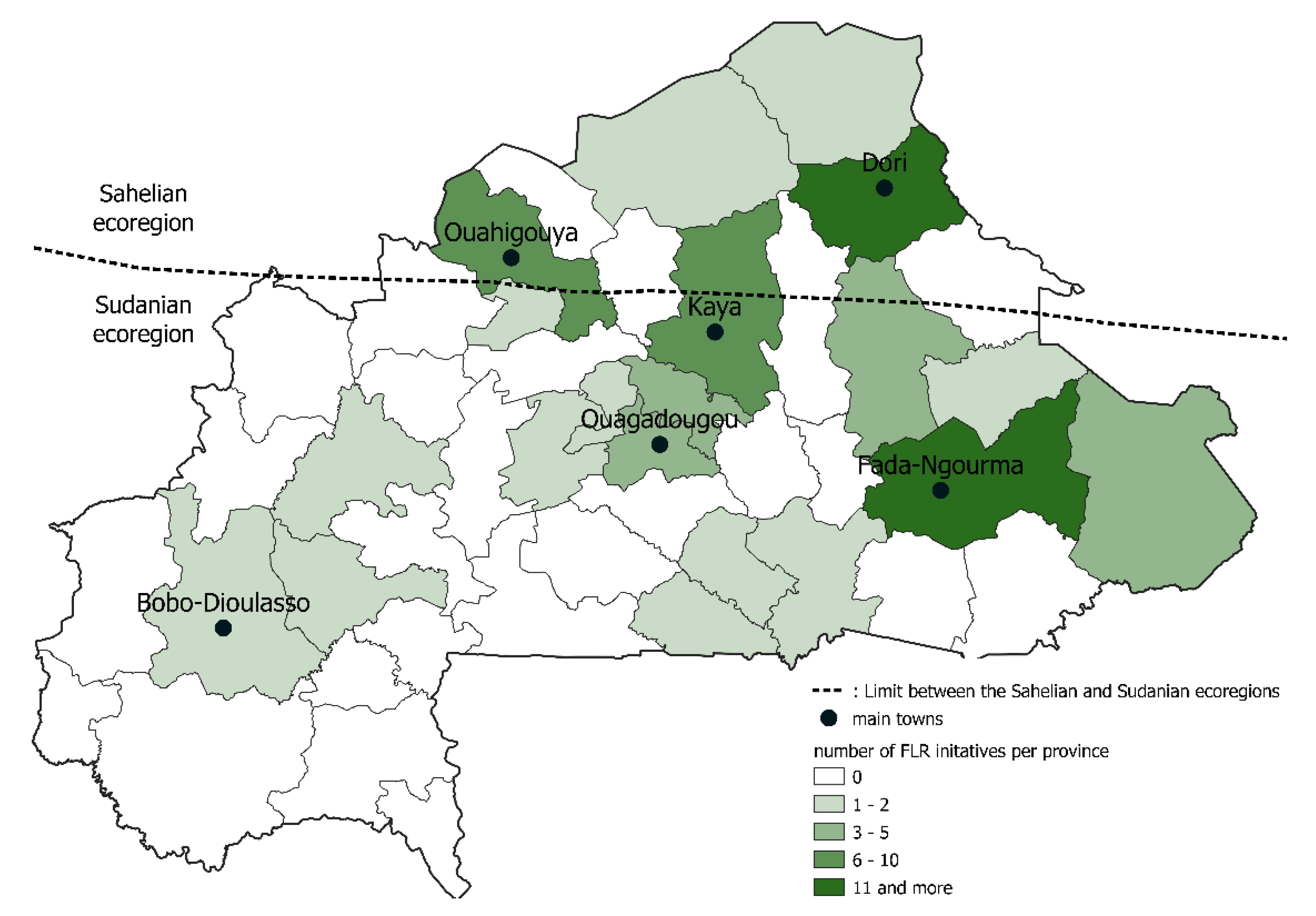
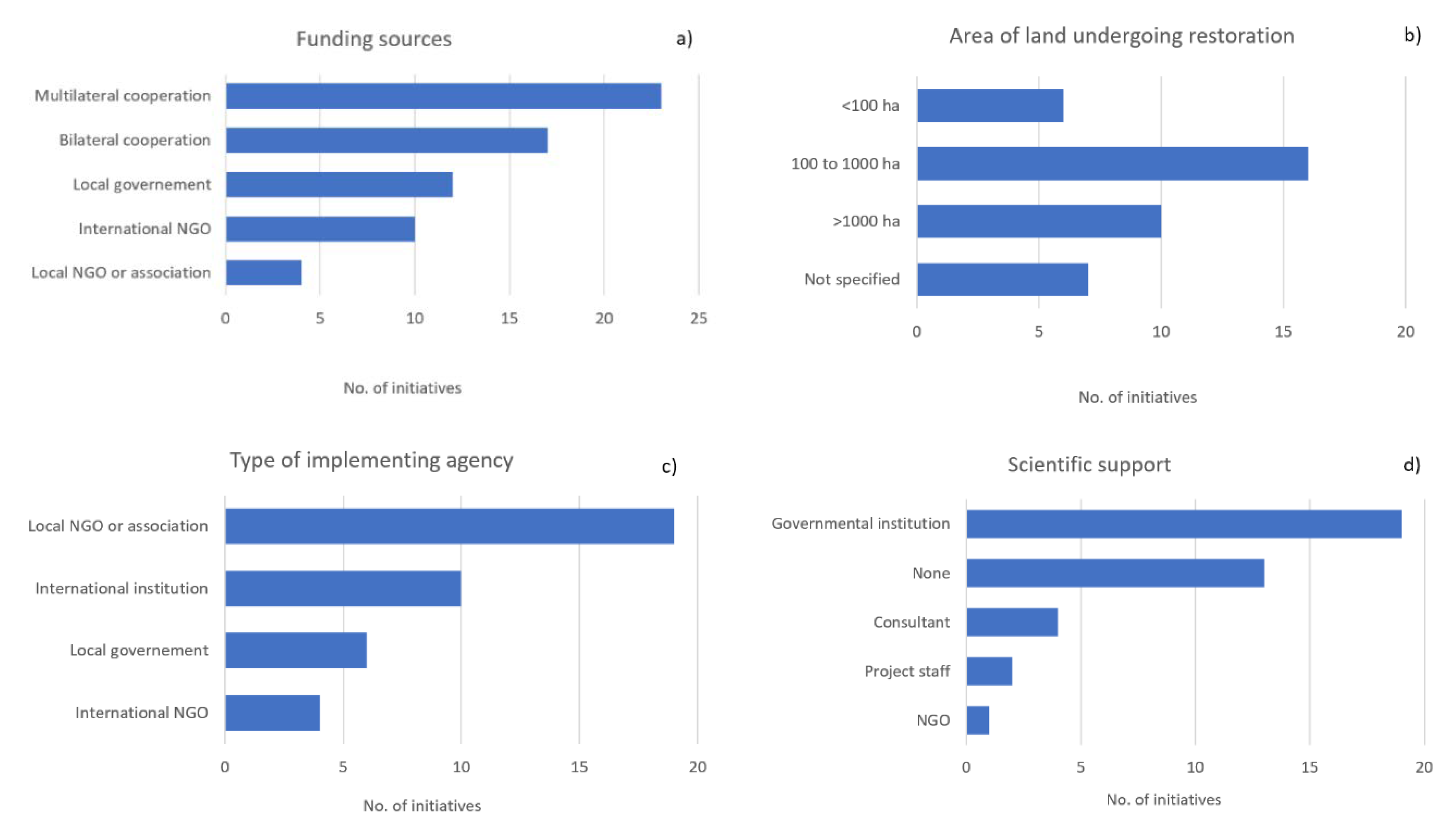
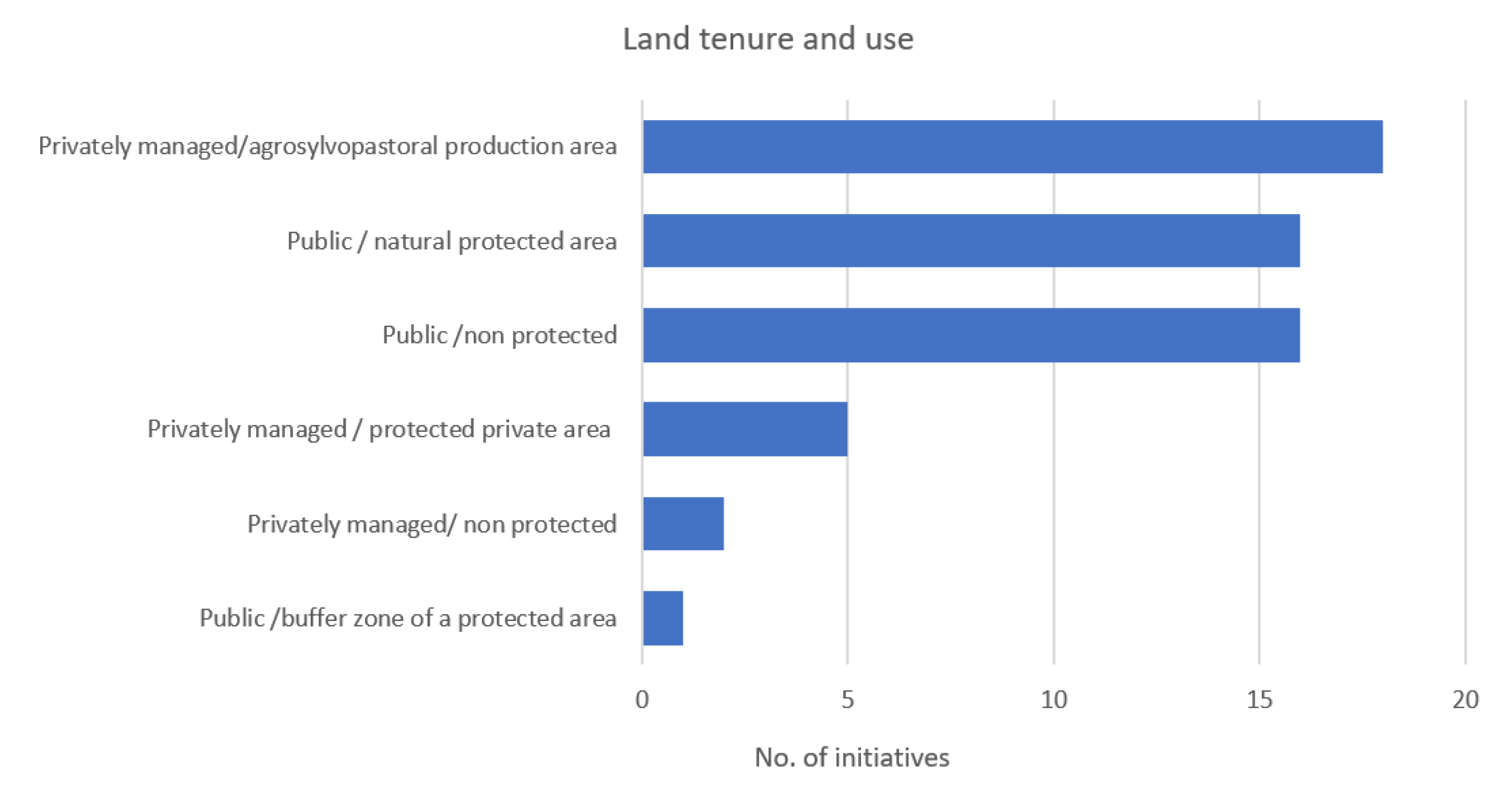
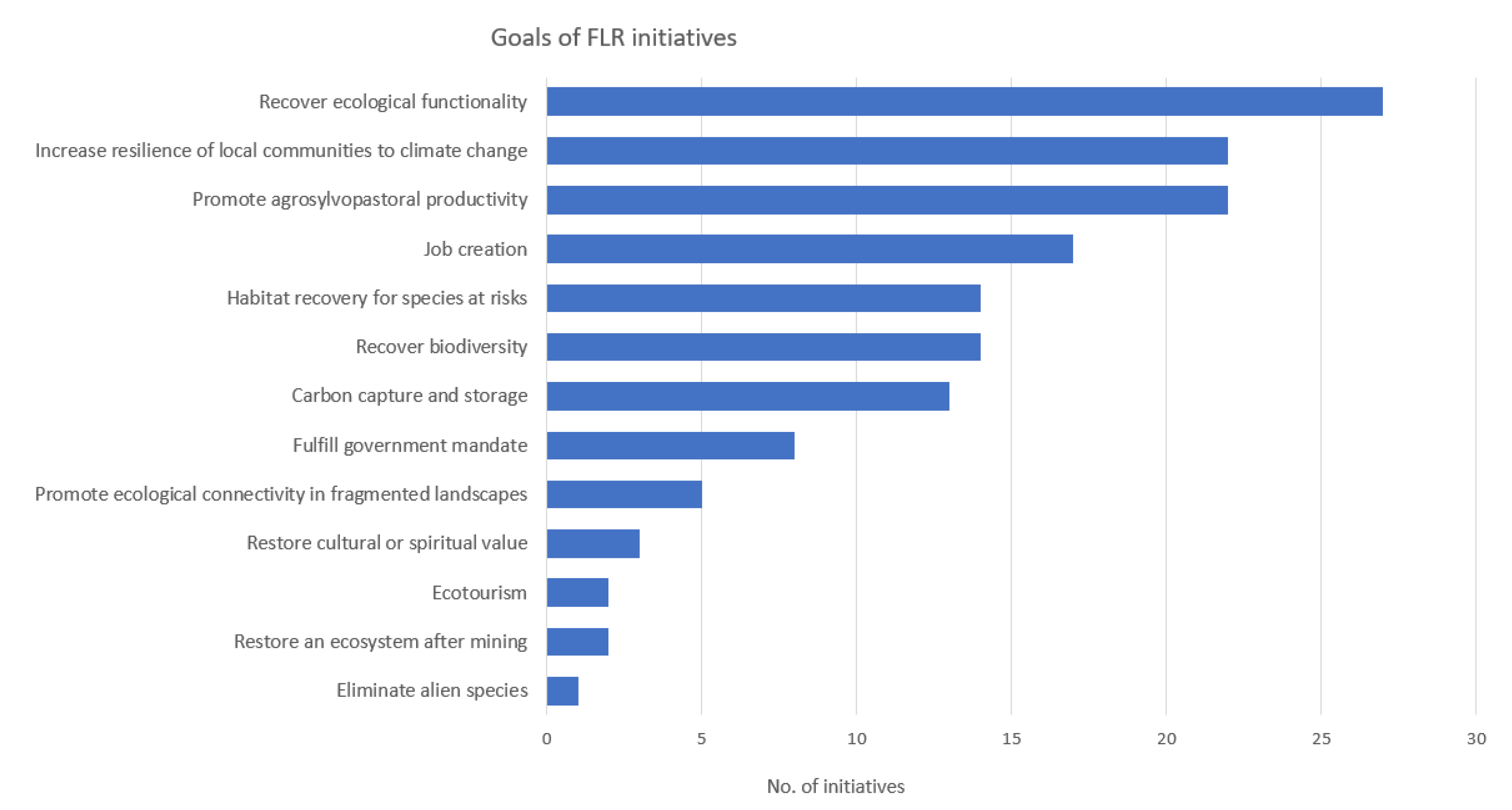
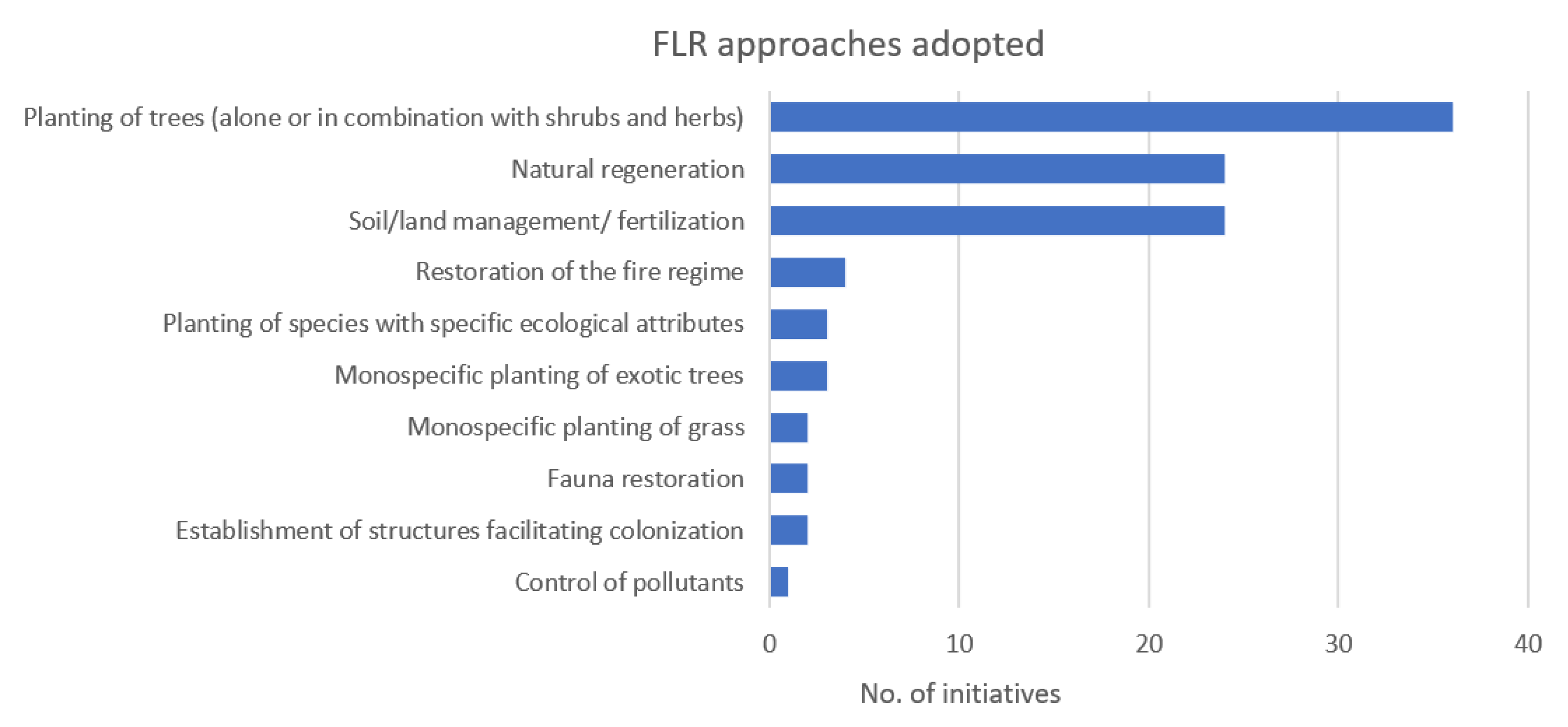

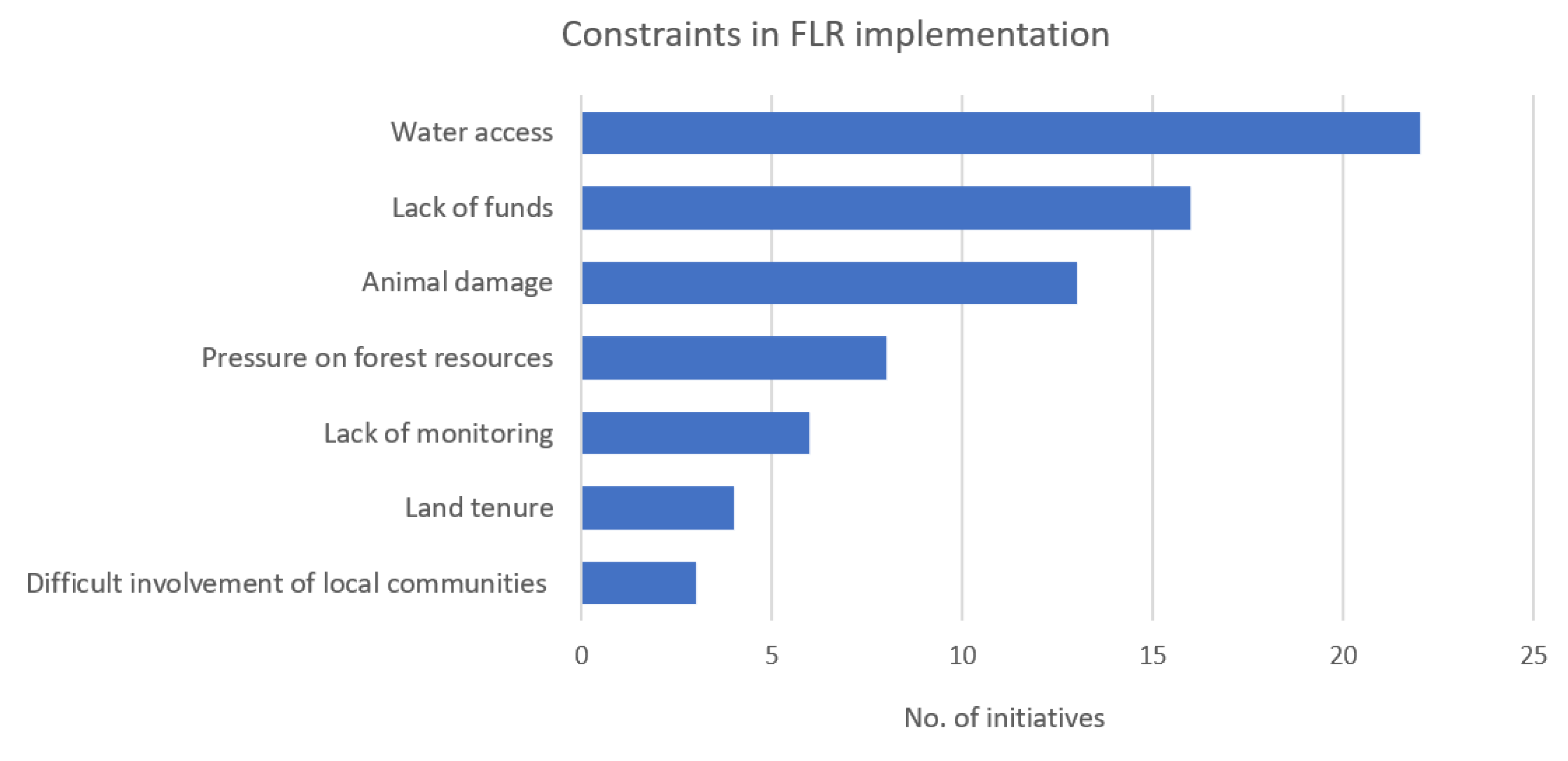
Publisher’s Note: MDPI stays neutral with regard to jurisdictional claims in published maps and institutional affiliations. |
© 2020 by the authors. Licensee MDPI, Basel, Switzerland. This article is an open access article distributed under the terms and conditions of the Creative Commons Attribution (CC BY) license (http://creativecommons.org/licenses/by/4.0/).
Share and Cite
Vinceti, B.; Valette, M.; Bougma, A.L.; Turillazzi, A. How Is Forest Landscape Restoration Being Implemented in Burkina Faso? Overview of Ongoing Initiatives. Sustainability 2020, 12, 10430. https://doi.org/10.3390/su122410430
Vinceti B, Valette M, Bougma AL, Turillazzi A. How Is Forest Landscape Restoration Being Implemented in Burkina Faso? Overview of Ongoing Initiatives. Sustainability. 2020; 12(24):10430. https://doi.org/10.3390/su122410430
Chicago/Turabian StyleVinceti, Barbara, Michel Valette, Ali Lardia Bougma, and Arturo Turillazzi. 2020. "How Is Forest Landscape Restoration Being Implemented in Burkina Faso? Overview of Ongoing Initiatives" Sustainability 12, no. 24: 10430. https://doi.org/10.3390/su122410430
APA StyleVinceti, B., Valette, M., Bougma, A. L., & Turillazzi, A. (2020). How Is Forest Landscape Restoration Being Implemented in Burkina Faso? Overview of Ongoing Initiatives. Sustainability, 12(24), 10430. https://doi.org/10.3390/su122410430




